My AMAZING Betta Aquarium And How You Can Have One Just Like It!
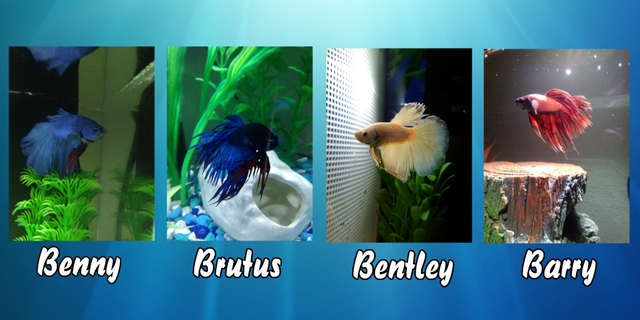
My Betta Family
In this article, I'm going to show off my betta family, but I'm also going to talk to you about how you can set up a beautiful betta aquarium without spending an arm and a leg. More importantly, I'm going to show you how to do it the right way, as there are a lot of myths out there about bettas and the types of aquariums they should be housed in.
Bettas are more commonly known as Siamese Fighting Fish, and they are easily one of the popular fish among aquarium hobbyists. While this may seem like a good thing, it has many downfalls. Mainly, people believe that these fish require very little maintenance and can be housed in tiny bowls. This is completely untrue, and it often leads to poor water quality which can shorten the lifespan of the fish considerably.
Another factor that is a major contributor to this myth is the way that pet stores house these fish. They are usually kept in tiny little plastic containers until they're bought. These containers are rarely cleaned and the water is not changed nearly enough. There is a reason why bettas must be kept in a container by themselves, however. They are very territorial fish and can be very aggressive toward other fish, particularly their own species. Surely, though, there must be a better system pet stores can employ than using these tiny containers.
Male betta fish cannot be housed with other male betta fish, as they will most definitely fight with each other, leading to torn fins, internal injuries, and even death. The fact that they must be housed separately from other bettas contributes to the myth that they "like" to be kept in small bowls. People believe that just because it's the only fish in the bowl, it doesn't need much space. The minimum space requirements for a single betta should be at least 2.5 gallons. Most betta hobbyists "in the know" actually keep their fish in a minimum of 5 gallons of water.
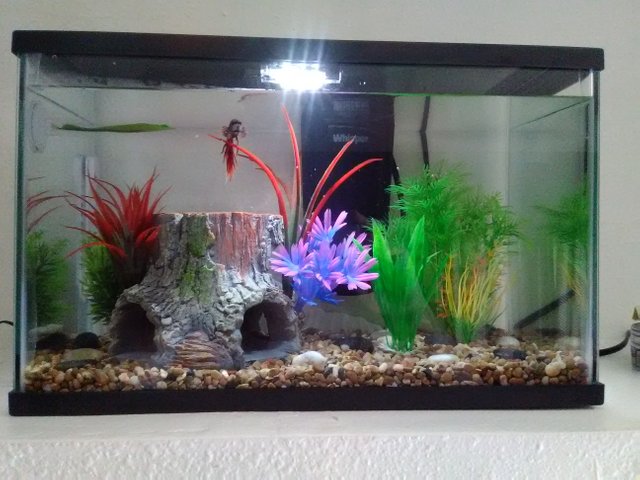
One Of My Crowntail Bettas In A 5 Gallon Tank
Female bettas can be housed together, under the right circumstances. A tank with several female bettas is referred to as a "sorority." Even in this case, however, the bettas will sometimes fight, so it's important to carefully select bettas by observing their behavior before adding them to a sorority tank.
Tips For Picking Out Your Betta
Here are some guidelines that I like to follow when choosing a new betta:
Water condition: The first thing I look for when choosing a betta is the condition of the water in it's cup. While not 100% foolproof, water that is clear and fresh looking usually indicates a healthy betta inside. If the water is full of uneaten food particles and excrement, this is an indication that the betta may have been there for quite some time and might not be very healthy. This is not always the case, however, and if you are like me, sometimes you will pick a fish like this on purpose so that you can take it home and give it a better life!
Color: Bettas are very vibrant in color. Vivid reds and dark, lush blues are most common. If the betta is happy and healthy, it's color will reflect that. If the fish's color is dull and pale, that's a sign that the betta may be malnourished or succumbing to ammonia poisoning brought on by poor water quality.
Activity: Take your finger and move it slowly across the container. Does the betta respond to your finger? Does it start to swim around quickly and respond to the movement of your finger or does it just lay on the bottom? Remember not to tap on the container, as this agitates the fish, but try to run your finger around the outside of the container and observe the results. Bettas are very curious fish and they always want to see what's going on outside of their container. If the betta is unresponsive and doesn't seem to be very interested in what's going on, that could be an indicator of poor health. However, keep in mind that's not always the case. He may just be resting, or might not feel up to playing with you.
Physical condition: Look for torn or damaged fins and scales. Also, look at it's eyes. The betta's eyes should be crystal clear and not hazy or cloudy. Another thing to check for is parasites. These will often manifest as small white spots on the body of the fish and in some severe cases, there will be bumps or deformities on the underbelly of the fish.
You will want to look very closely when you pick out your betta, because as I stated, they are often not kept in optimal conditions at the pet store. The below image is commonplace when it comes to betta displays.
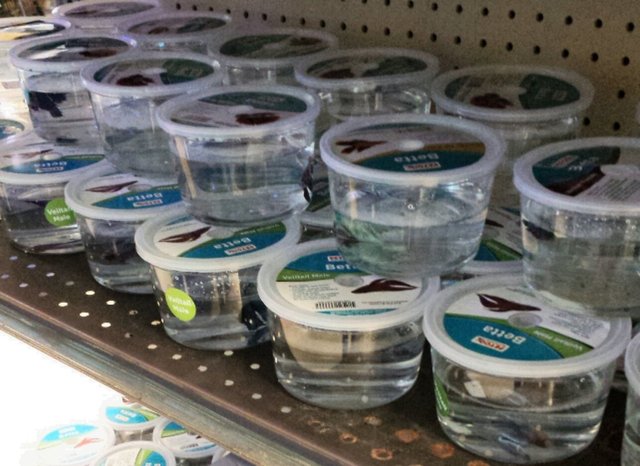
Image Source - The Dodo
What You'll Need
I'm going to individually list everything that you will need, but as I said, you can often find kits that come with all of this.
A Fish Tank: This pretty much goes without saying. If this is your very first betta, I recommend going with a 2.5 gallon tank. There are a lot of advantages to starting small, especially if you are new to the hobby. First and foremost, the smaller environment will make it easier to learn how and maintain optimal water conditions. Second, it will be much easier to clean and maintain the tank itself.
A Filter: Contrary to popular belief, betta fish require a filter. Filters help you to keep your water as clean as possible, and they also help circulate the water in your tank. For a 2.5 gallon tank, you'll want to purchase the smallest filter possible. If the filter is too large, it may move the water too quickly, and this is agitating to a betta, whose natural habitat is mostly calm, shallow water.
Decorations: Decorations include things like gravel or sand to line the bottom of your tank, artificial plants, statues, caves, and other models of items which can be found on the real ocean floor. Bettas prefer live plants, but that can take time. If you opt for artificial plants, buy silk plants if you can afford them. I have to admit, I use plastic plants in my betta tanks, but I always make sure they are super soft and don't have any jagged edges or branches that could tear the betta's delicate fins.
A Heater: If you live in an area with a relatively colder climate, you may require a heater for your tank. Again, you'll want the smallest heater you can find for a 2.5 gallon tank. Some heaters have a temperature control, but many of the smaller ones do not. If you can get a heater with a temperature control, you should go for it. Bettas are a tropical fish, so they like their water temperature between 76-80 degrees fahrenheit.
A Net & Cleaning Brush: You'll definitely need to purchase a small net to move your betta back and forth when doing cleanings and water changes, and it's a good idea to buy a brush to use to clean the inside of your tank. These are relatively inexpensive, but very useful items.
Betta Food & Water Conditioner: This is extremely important. You will need to buy he right kind of food for your fish and you will definitely need water conditioner. Betta food comes in pellets or flakes, but most people feed their bettas pellets. It's easier to regulate their diet that way and make sure they are always consuming the same amount of food. As a treat, you may want to buy a bottle of freeze dried blood worms. Most people use these as a special treat and feed them to their fish 2-3 times a week. One or two blood worms at the most is enough, and that should be substituted for their regular meal. Water conditioner is used to turn your tap water into water that you can use in your fish tank. These two items regularly come in beginner's tank kits.
A Thermometer: You'll need a thermometer so you can monitor the water temperature in your tank. Remember, 76-80 degrees fahrenheit is where you want your water to be. It's best if you can keep the temperature steady all the time.
A Suction Vacuum: These are sold at most pet stores, and there are several different sizes. They are basically a piece of hose with a plastic tube on the end and they work using suction. These come in handy for cleaning because you can easily vacuum all of the uneaten food and fish waste that collects on your gravel. This will help keep your tank much cleaner and will cut down ammonia levels. If ammonia levels get too high it can be fatal to your fish.
My Five Gallon Tank
Setting Up Your Tank
Here's how I set up my tanks:
You'll need to take out the directions and assemble your tank and filter. Don'y worry! This is not difficult. Most sets come with illustrated manuals that are quick and easy to follow. Once you have your filter assembled and installed, next you will want to add your heater and thermometer.
The second thing you'll need to do is rinse your gravel several times to remove the natural dust that is inside the package. You will then want to rinse off all of the decorations you bought. Do not use soap of any kind. Finally, rinse the inside of the tank out to remove any dust or residue that doesn't belong there.
Once your gravel and decorations are clean, you can add your gravel to the bottom of the tank. Line the bottom with about one inch of gravel. Go ahead and add your artificial plants and any decorations you may want to use. This is when it comes time to bring out your artistic side and use your creativity to make a nice "aquascape" inside the tank. Make sure your betta has plenty of plant cover and a nice cave to cover down and feel safe in.
Add water. Now it's time to fill 'er up! I usually take a plastic water pitcher and a large slotted spoon when I fill my tank up. You'll also want to set aside a clear 6-8 inch tall drinking class or plastic container. You'll need to test your tap water to get it within the proper temperature range for your betta. The easiest way to do this is to run your tap water until it feels lukewarm to the touch. Fill up your plastic container with tap water and place your thermometer inside of it. Read the temperature and adjust your tap water until it reads between 76-80 degrees F. When you get it where you want it, use your plastic pitcher and pour the water through your slotted spoon. This way you can add your water without disturbing the gravel and decorations you put in earlier.
Condition your water. Most sets come with a bottle of water conditioner, and some don't. At any rate, I recommend buying a bottle just to have. You will need plenty of it. Water conditioner removes chemicals called chlorines and chloramines from the tap water, which are two chemicals that are very harmful to bettas. The most popular brands are usually in small yellow bottles and will read "betta water conditioner." Read the instructions on the back for how much to add to your tank. Most conditioners call for 7 drops per 1 gallon of water.
Once you have filled your tank to the recommended fill level and added your conditioner, you will want to plug in your filter and heater (if necessary). If all is working well, you will want to get the container that's housing your betta and make sure the cover is on tight. Carefully place the entire container in the tank. It should stay afloat and the water inside the cup should not escape. Let the container with your betta float around in the tank for at least 1 hour. You are doing this to slowly accustom your fish to the water temperature in the tank so that when you finally put him in the water, it will not shock his system. If you move your betta from warm water to water that's too cold, it can cause temperature shock and kill your betta.
Release your betta into the tank. If possible, you want to try to avoid using a net to handle your betta. Nets can be very rough on a betta's delicate fins and scales. However, sometimes it's necessary. In this case, I would simply recommend holding your net over the tank and gently pouring the contents of the betta's small container into the net. Once your betta is in the net, gently turn over the net and slowly release the betta into it's new home.
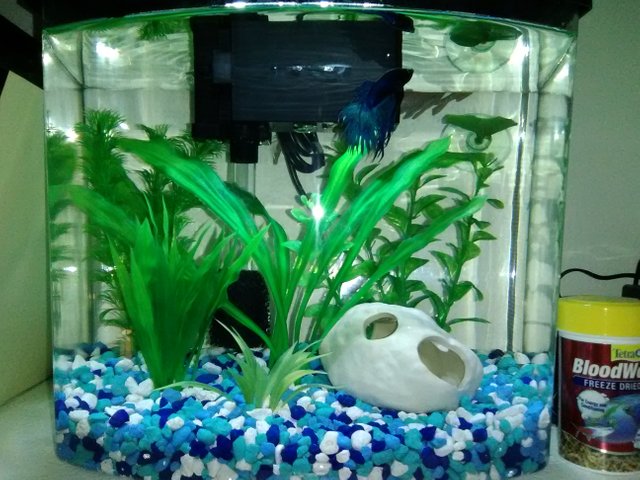 My 2.5 Gallon Tank
My 2.5 Gallon TankFeeding & Cleaning
Feeding is relatively easy. There is one major thing you do not want to do with a betta, however, and that's overfeed it. A bettas stomach is about the same size as one of it's eyes. In other words, it's not very big, and if a betta is overfed and gets bloated, it can lead to some very serious problems. I feed my bettas one pellet twice a day. Basically, they get 2 pellets per day. I also give them a freeze dried blood worm 2-3 times per week. These are a treat and should replace the regular meal, not be added to it.
I feed them twelve hours apart. One thing that is important to mention is that you will want to set up a day/night environment for your betta. Just as a human being has a day and night, a betta needs that as well. Your tank light simulates day, and when your light is off, it simulates night. I turn my light on at 7am and off at 7pm. However, you can choose whatever cycle you like, as long as it's consistent.
Cleaning your tank is easy. The recommended maintenance schedule for your tank should be a water change at least once a week, and a full cleaning once every two months. Weekly water changes do not mean that you have to empty your tank fully. It's recommended that you change 25% of the water every week and then once every two months you can do a full cleaning. You can rinse your rocks and decorations, and change your filter cartridge as needed. Some filter cartridges should be changed once a month. Read the instructions for your particular filter and follow that schedule. Remember not to forget to add the proper amount of conditioner when you do a water change.
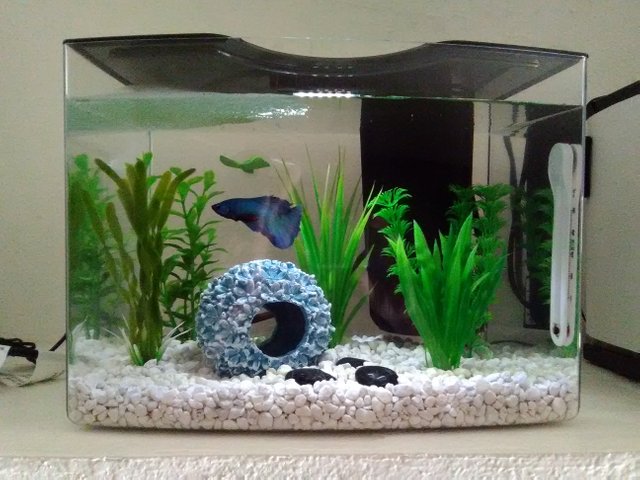 My 3 Gallon Tank
My 3 Gallon Tank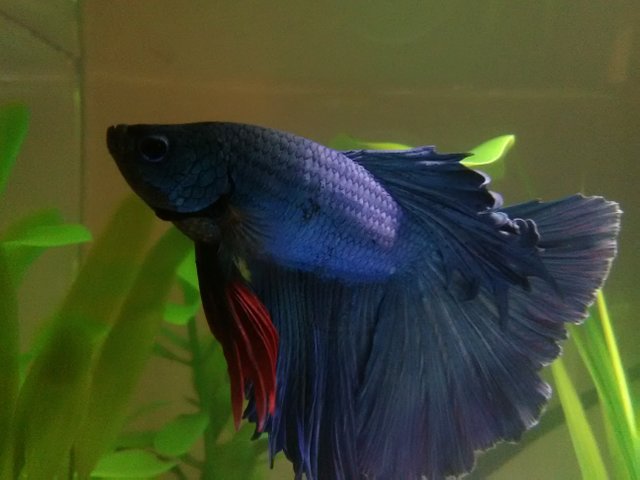 Benny, My "Halfmoon" Betta
Benny, My "Halfmoon" Betta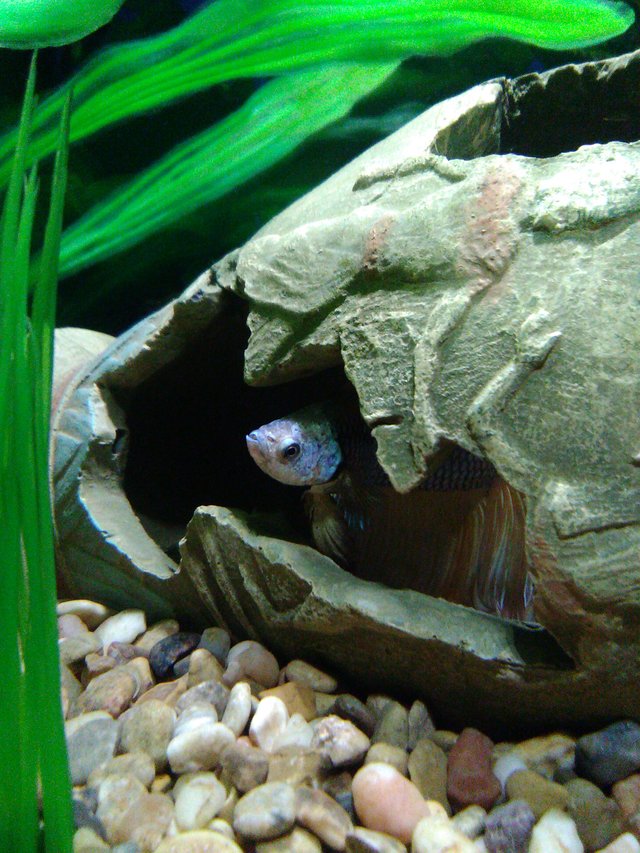 Bentley Hiding In His Cave
Bentley Hiding In His CaveBubble Nests
This is called blowing a bubble nest. Only male bettas blow bubble nests. Many people believe that when a betta is blowing a bubble nest, that means he's happy or content.
While that may be partially true, it's not why they do it. A male betta starts blowing a bubble nest when he is ready to mate, or in betta terms, spawn. The male uses the bubbles to house little betta eggs. After betta spawn, the female will lay her eggs. The male will pick up the eggs with his mouth and insert them into the bubbles in his nest. It's there that they will hatch. It's a really cool thing to see!
However, it really has more to do with instinct than happiness. However, bettas usually only blow bubble nests when everything feels right, and that includes the condition of their water. In other words, if you catch your betta blowing a nest, you should take it as a complement because it means you are keeping your betts's water just right!
Here's a video of my blue Halfoom betta (Benny) making a bubble nest. He's really going at it!
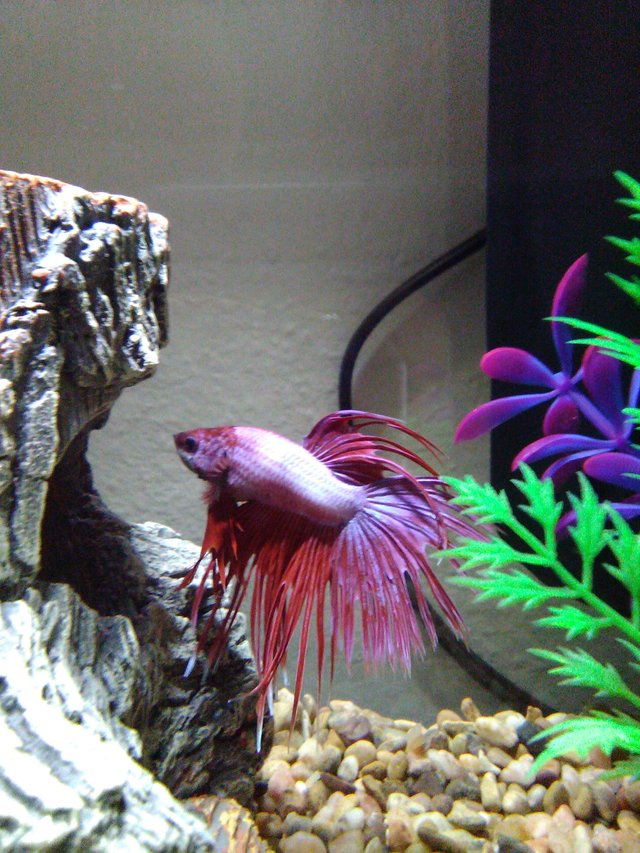 Barry, My Red Crowntail Betta
Barry, My Red Crowntail Betta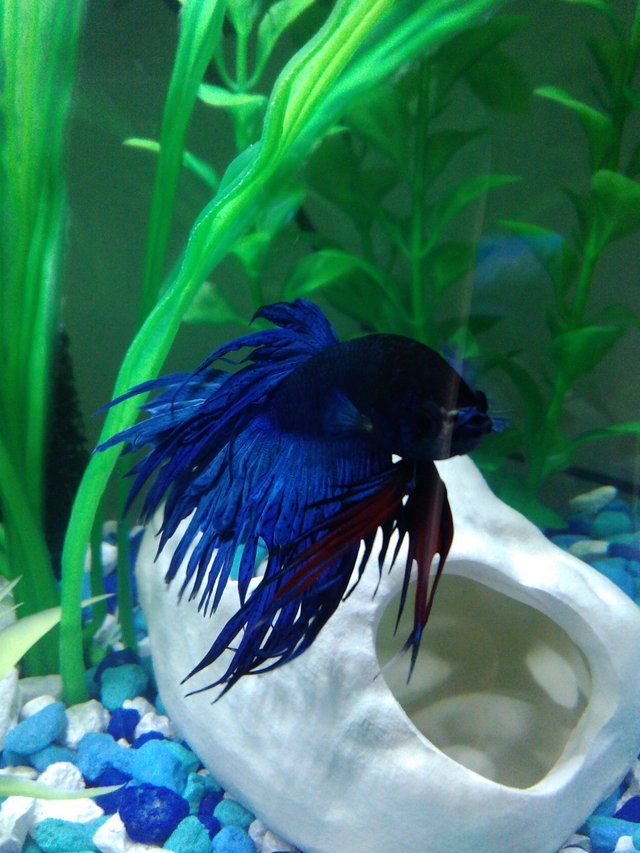 Brutus, My Blue Crowntail Betta
Brutus, My Blue Crowntail BettaI also wanted to include this really helpful video which shows how to set up a 2.5 gallon betta tank. I didn't make this video myself, but it's really great and I think you will find it very helpful when you set up your tank.
Well, I sure hope you found that article helpful and I hope that I have at least made you think about getting a betta. They make awesome pets and they are so interesting to watch. It's really cool to see that they have their own personalities, too. They are truly unique fish!
Helpful Online Resources

Nice Crowntails and Rosetails. I see you've got rare lemon color fish :)
I've had a spawn recently, they're one week old. :) They're "just" veiltails but very special looking. I'll post pics sometimes. I've recently prepared a map of all betta kinds. I invite you to have a look Betta Fish Types and Colors
Thanks for your comment! I checked out your post and thought it was great! Keep up the good work! BTW, I think Veiltails are beautiful bettas!
I Like Cute Little Fish!
Those are some great photographs of your fish.
Thanks so much! I really appreciate the complement!
I don't see how they survive long in those little cups. I really like Brutus. So when are you going to get a Barbara and Betty to start a sorority for the boys to gawk at? Lol. Outstanding article! Top notch.
Thanks! I know I need to get a few girls for my boys LOL!
No ce tank. Very clean and clear
Thanks! I try to always take the best care of them.
beautiful betta fish. i like it. If you have fry, i found the trick for calling the fry to make gather. I use it if i want to feed and if i want to shiffon. Came here to see how it works. https://steemit.com/call/@nasirahmad06/how-to-call-baby-betta-fish-cara-memanggil-anak-ikan-cupang